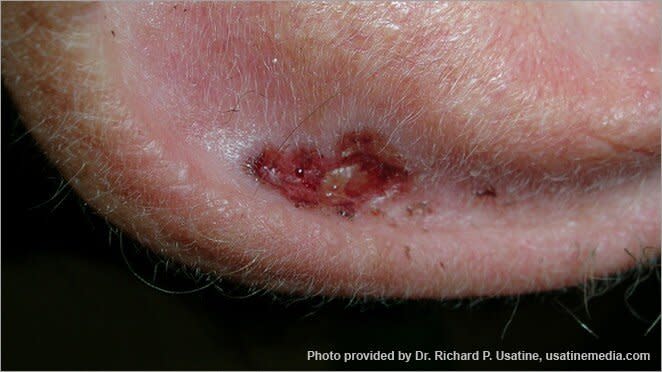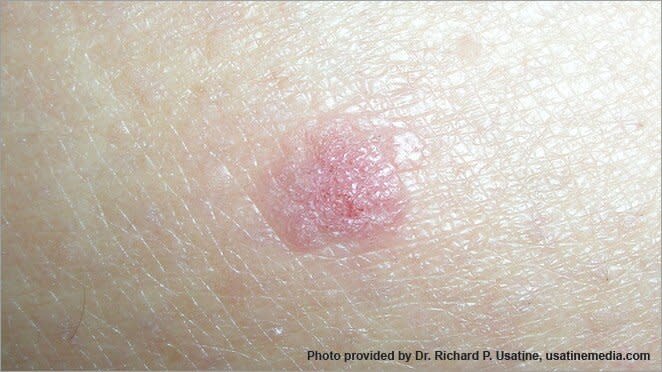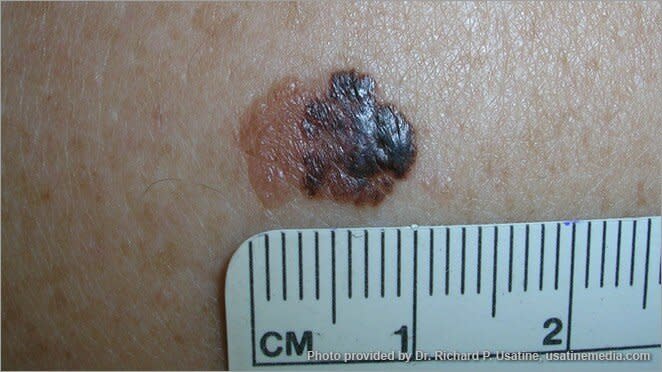Suspicious New Spot or Changing Mole? These Pictures Can Help You Check for Skin Cancer

Photoboyko/Getty
There's no denying it: spending time in the sun can feel pretty damn good, especially after a long winter. And as long as you're wearing SPF and not burning, you're in the clear when it comes to skin cancer, right? Wrong. The truth: There's no such thing as a healthy tan. Seriously. That's because both tans and sunburns result in DNA damage that can pave the way to the big C. (Related: The Best After-Sun Lotions for Your Parched Skin and Lobster-Red Burn)
The Skin Cancer Foundation estimates that one in five Americans will develop skin cancer before age 70, making it the most common cancer in the U.S. What's more, over 9,500 people are diagnosed with skin cancer every day and more than two people die of the disease every hour in America, according to the foundation. And as you've likely heard before, a person's risk for melanoma doubles if they have had five or more sunburns in their life, says Hadley King, M.D., a dermatologist in New York City. A family history of skin cancer will also increase your risk. Still, everyone with sun or other UV exposure (such as from tanning beds) is at risk of developing skin cancer.
Prevention, such as wearing SPF daily, is step one. But familiarizing yourself with what different forms of skin cancer look like can help you potentially spot what's normal and what's not and, in turn, could very well save your life. If you've noticed a changing mole or a suspicious red spot on your nose, you should definitely examine it and make sure that you're getting your regular skin cancer check with your doc.
"Skin could be snow-white or chocolate brown, but you're still at risk," says Charles E. Crutchfield III, M.D., clinical professor of dermatology at the University of Minnesota Medical School. However, it's true that people with fair skin have less melanin and therefore less protection against UV rays, which increases the risk of getting a tan or sunburn. In fact, white people are 20 times more likely to receive a melanoma diagnosis compared to African Americans, according to the American Cancer Society. The concern with people of color is that skin cancer is often diagnosed later and in more advanced stages, when it's more difficult to treat.
Now that you have the basic risk factors down, it's time to move on to the not-so-pretty part: what you should watch out for on your skin. If you've ever felt worried about a suspicious mole or abnormal skin changes or googled "what does skin cancer look like?" — and even if you haven't — then read on.
Non-Melanoma Skin Cancer
Skin cancer is categorized as melanoma and non-melanoma. The most common type of skin cancer is non-melanoma and there are two types: basal cell carcinoma and squamous cell carcinoma. Both types are directly correlated with your total cumulative lifetime sun exposure and development in the epidermis, aka the outermost layer of your skin, says Dr. King.
Basal Cell Carcinoma (BCC)
Basal cell carcinomas are most common on the head and neck. They typically show up as an open sore or skin-colored, red, or sometimes dark-colored bump with a pearly or translucent border that appears rolled. Basal cell carcinomas can also appear as a red patch (that may itch or hurt), a shiny bump, or a waxy, scar-like area.
While the most frequently occurring type of skin cancer, they rarely spread beyond the original site. Instead of metastasizing like melanoma, a basal cell carcinoma attacks the surrounding tissue — making it less deadly but heightening the chance for disfigurement, according to the U.S. National Library of Medicine (NLM). Basal cell carcinomas are usually surgically removed and require no additional treatment, says Dr. King.

Squamous Cell Carcinoma (SCC)
Squamous cell carcinoma is the second most common form of skin cancer. Squamous cell carcinomas often look like scaly red or skin-colored patches, open sores, warts, or elevated growths with a central depression and may crust or bleed. They will also need to be surgically removed, but are more serious because they can spread to the lymph nodes and have about a 5–10 percent mortality rate in the United States, says Dr. King.

Melanoma Skin Cancer
Love 'em or hate 'em, it's important to know what your moles look like and how they've evolved because melanoma skin cancer often develops from mole cells. While not the most common, melanoma is the most dangerous type of skin cancer. When diagnosed and treated early, melanoma is curable — however, it can spread to other parts of the body and become fatal if gone untreated.
Unlike non-melanoma skin cancer, the sun exposure pattern believed to result in melanoma is that of brief, intense exposure — for example, one blistering sunburn rather than years of tanning, says Dr. King. Melanomas generally appear as dark lesions with irregular borders, adds Dr. Crutchfield. Decoding doctor-speak, a lesion is any abnormal change in skin tissue, such as a mole. Knowing your skin's baseline is key so that you can notice any new moles or changes in existing moles or freckles.

The ABCDEs of Moles
The method of identifying cancerous moles is called the "ugly duckling sign" because you're looking for the odd one: the mole that is a different size, shape, or color than the surrounding moles. The ABCDEs of moles will teach you how to spot skin cancer — the ugly ducks, if you will. (You can visit the American Academy of Dermatology website for more images of how to spot the suspicious moles.)
Asymmetry: If you could "fold" a mole in half, both sides of an irregular one would not line up evenly.
Border irregularity: Border irregularity is when a mole has a crooked or jagged edge rather than a round, smooth edge.
Color variation: Some moles are dark, some are light, some are brown, and some are pink, but all moles should be the same color throughout. A darker ring or different colored splotches (brown, tan, white, red, or even blue) in a mole should be monitored.
Diameter: A mole should be no larger than 6mm. A mole larger than 6mm, or one that grows, should be checked by a derm.
Evolving: A mole or skin lesion that looks different from the rest or is changing in size, shape, or color.
Other Warning Signs of Skin Cancer
Skin lesions and moles that itch, bleed, or won't heal are also possible alarm signals of skin cancer. If you notice the skin is bleeding (for instance, while using a washcloth in the shower) and does not heal on its own within three weeks, go see your dermatologist, says Dr. Crutchfield.
How Often to Check for Skin Cancer
Yearly skin exams are typically recommended as a preventative measure, says Dr. Crutchfield. In addition to a head-to-toe exam, they can also take photos of any suspicious moles. (Related: Why You Should Get a Skin Cancer Screening at the End of Summer)
A monthly skin check at home is recommended to check for new lesions or to monitor any changes in atypical moles. Do the skin check standing naked in front of a full-length mirror in a room with good lighting and holding a hand mirror, says Dr. King. (Don't miss forgotten spots such as your scalp, between your toes, and nail beds). Get a friend or partner to do a check of hard-to-see places such as your back.
Bottom line: There are many types of skin cancer, each of which can look different from person to person — so go see your doc if you notice any marks on your skin that are new, changing, or otherwise worrisome. (Here's exactly how often you really need to have a skin exam.)
When it comes to identifying the big C, the best advice is "see spot, see spot change, see a dermatologist," according to Dr. Crutchfield.

